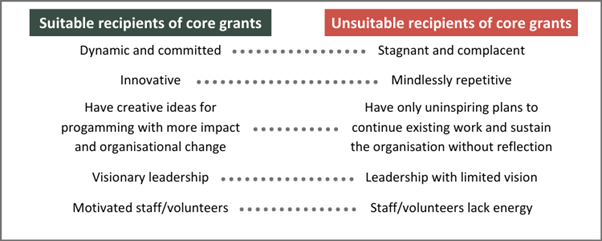
By Rod MacLeod
This blog is a product of research on core grants commissioned by the Laudes Foundation. This is a topic that has been rising up the agenda and Laudes Foundation has increasingly been using this funding mechanism itself. The aim of the research was to learn lessons from the provision of core grants in the wider sector. It involved a literature review and interviews with donors, recipients and observers of the sector, as well as the author’s own experience as a practitioner and a consultant. The full paper can be accessed here.
Blogs in this series:
No. 1: Core grants: Why isn’t everyone using them?
No. 2: How to select suitable recipients of core grants
No. 3: How to use a core grant
No. 4: How to measure the impact of core grants
Many donors are increasingly turning towards core grants [1] as an effective funding mechanism. There are many advantages and proponents argue that this is the way to achieve a higher impact as compared to more restricted (e.g. project) grants. The potential benefits of core grants include:
- Allowing more flexible, adaptive approaches;
- Providing more scope for innovation;
- Enabling organisational development and transformation;
- Leveraging other funding and income;
- Changing the nature of the donor-recipient relationship.
But when and how to select suitable recipients? This blog sets out the some of the main issues to consider.
Different donors deploy core grants in different ways. Some use them as their principal funding mechanism (e.g. People’s Postcode Lottery). Others see them as part of a wider suite of funding instruments, which also includes restricted grants (e.g. the David and Lucile Packard Foundation). Furthermore, donors have different objectives. For some, core grants are open-ended support to trusted organisations (albeit renewed every 3-5 years), for as long as they consider recipients to be doing good, relevant work (e.g. Irish Aid, Danida). Other donors see core grants as being time-limited interventions to enable organisations to get to the next level (e.g. Comic Relief).
Whatever the objectives, there are fundamental choices to be made about which recipients are most suited to this most sought-after of funding mechanisms.
In making decisions, it is important to bear in mind that, while core grants can have many benefits, they are not a panacea. Indeed, when recipients take flexible funding for granted and use it solely to fill funding gaps and avoid hard choices, it can actually be detrimental. Distinguishing between worthy and wasteful recipients can be seen in terms of a spectrum, the ends of which are as follows:

These are stereotypes and every organisation is unique and constantly evolving in various ways along this spectrum. However, this does highlight some of the key considerations.
Identifying suitable recipients of core grants is as much an art as a science. There is no blueprint for success and reviewing documents and scoring against checklists alone will not necessarily lead to the best choices. The qualities and characteristics described above are not easily measured. One donor spoke of the feeling she gets when she enters the potential recipient’s office as a guide to their suitability: it is evident in the people and the culture. This is not to ignore the importance of clear planning, due diligence, adequate systems, structures and procedures, but a recognition that an assessment should go beyond this to take account of less tangible elements.
A core grant means investing in a whole organisation, rather than a particular programme. The choice therefore requires a wider understanding of an organisation’s vision, niche, ideas, leadership, internal dynamics and capabilities. It means spotting the right moment when an organisation is ready to take off and move to another level. It also entails progressively building a relationship. Some liken this to a developing human relationship – from the initial introduction leading up to the marriage. People commit in a relationship, in part, because they can trust the other person and the same applies to a core funding relationship.
This is easier for foundations, whose accountability is mainly to their own boards. Government donors have to demonstrate fair and transparent processes for all potential applicants and are more constrained in how they can build relations with partners.
Determining what proposal to use
Inevitably there will be some documentation required to define the core grant and how it will be used, as for any other funding arrangement. Proposals vary, with some wanting clear intervention logic and results frameworks (this applies increasingly to government donors).
Others prefer to keep it more open, arguing that requiring too much specificity from a grantee undermines the rationale and benefits of a core grant. A number of donors simply take the potential grantee’s strategy, since they are funding the whole organisation. For budgets, they can comprise just one line – the total amount requested – without any need to provide more detail than this.
Conclusion
The process of selecting suitable recipients of core grants is vital – both to choose the right organisation, but also to put the new ‘donor-recipient’ relationship on the right footing. A rigid bureaucratic selection process (such as that typically used to assess project grants), may not always identify where there is most scope for the transformational change and the impact that core grants can catalyse. There may be less work needed forensically going through detailed action plans, logframes and budgets. But it takes at least as much time (and particular donor skills) to gain an in-depth knowledge of an organisation and to appreciate its potential future trajectory. Possible pitfalls are real, but get it right and the results can be spectacular.
[1] By ‘core grants’, we are discussing donor funding with a high degree of flexibility, which can be used to cover organisational development work and the administrative running costs of the organisation, as well as programmatic work.